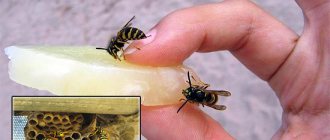If you are tired of trying to scare away moles with rotten fish and firecrackers exploding in the passages of the animals, then it’s time to look at the problem more broadly - today there are much more effective remedies for moles in the dacha, it is only important to correctly understand the available variety and choose those that really work on practice.
But many summer residents have difficulty choosing effective means. Some people don’t want to worry too much about this and understand the problem in detail - it’s much easier to pour cat urine or kerosene into the minks, in the hope that, perhaps, it will help. And only when the site becomes so pitted with moles that it turns into a kind of tank training ground, when there are more beer cans mounted on pegs and designed to repel pests than there are plantings on the site - then the most favorable moment comes to try more effective means, about which We'll talk further and in more detail.
Below is a detailed overview of the most popular and affordable mole repellents, including some very effective ones. Perhaps, having studied this information and applied it in practice, you will finally be able to control moles in your summer cottage this season and not have problems with them in the future.
Namely, the following will be considered:
- Effective means of catching moles;
- Deterrents;
- Specific means of killing and repelling moles;
- As well as means of mechanical protection of a summer cottage from the penetration of new moles from the outside.
But first things first…
Mole traps
Without exaggeration, we can say (and practice confirms this) that traps are the most effective means of combating moles on the site. When used correctly, they allow you to get rid of these animals in the garden in most cases.
Traps are also good because they give a visible and, so to speak, unambiguous result: if a mole is caught, the result immediately becomes obvious. In this way, traps compare favorably with repellents, when using which the gardener has to guess whether the repeller worked or not, whether the moles left, or simply hid, remaining in the summer cottage (or they left, but to the neighbors, and will soon return).
Perhaps the main disadvantage of traps is the relative complexity of their use. To install the product, you still need to be able to place it correctly on the site, and to do this you have to dig out the mole’s passages. It is also important that traps do not provide absolute protection from moles in the countryside - they can only catch animals that are already on the site and periodically enter it from the outside.
On a note
In addition, when using traps, the gardener is forced to come into contact with the animal in one way or another. For example, you need to remove a mole from a live trap and then take it outside your summer cottage, which can be difficult for people who are afraid of small animals. And various traps and snares kill moles, often in a cruel and painful way, which is unacceptable for many gardeners, since it is not humane.
Let's now look at which mole traps are most often used in practice.
Live traps and their features
Live traps for moles work on a simple principle: the animal easily falls into the trap, but cannot get out of it.
Typically, such means of catching moles are implemented in two versions:
- A pipe trap installed during the mole's course. Another name is Solomon's trap. The animal easily lifts the door and gets inside, but cannot open the door to get out. The price of such a mole trap is 400-1200 rubles, depending on the design and manufacturer. However, you can make such a remedy for moles with your own hands - from a plastic water pipe or even from ordinary plastic bottles;
- A pit trap, which is a pan, bucket, wide plastic bottle or glass jar, buried under the mole's path. The animal simply falls into it and cannot get out. Made by hand.
These seemingly very simple traps are in fact very effective remedies against moles: when used correctly, it is often possible to rid a dacha of pests in a fairly short time. Insufficient effectiveness of using traps and lengthy struggles are usually associated with the wrong choice of location for installing live traps.
Review
“We were advised to use a pipe trap to prevent moles at our dacha. It cost about 500 rubles on the Internet, we bought it, my husband buried it, and lo and behold, after 2 hours the mole was caught! I thought they only crawled at night. His husband took him somewhere to the river and released him there. We didn't have any more of them all summer. Apparently, only one mole made all these holes for us...”
Evgenia, Pskov
To be fair, it must be said that using live traps is quite a troublesome task (especially if you really focus on the most humane means of fighting moles):
- Firstly, the mole trap-pipe must be carefully dug into the course so that it seems to continue it. As for the pit trap, the “pit” should be dug even deeper, which requires some effort. If the animal is not caught for a long time, then it is necessary to change the location of the traps on the site;
- Secondly (and this is the most troublesome thing), live traps need to be checked regularly - at least once every 4-5 hours. The fact is that moles have a very fast metabolism, and if they do not eat, they die within 18-24 hours. In this case, the live trap would turn from a humane means of fighting moles into a real torture chamber, since the caught animal would die a painful death from starvation ;
- Thirdly, the caught mole must be taken outside the site at a distance of at least 1 km - then it will definitely not come back.
It is quite understandable that many gardeners are put off by such difficulties associated with the use of live traps.
On the other hand, the use of live traps against moles is a humane method for animals and a completely safe method of pest control for people. In general, live traps can be used in almost any case - these are effective remedies for moles in the garden for those plot owners who want to quickly get reliable results without killing the animals themselves.
Traps and lethal traps
The main advantage of any product from this group is the combination of high efficiency (typical of traps in general) with ease of use. If you install the trap correctly, it will simply kill the mole without additional effort and loss of time on the part of the gardener.
The main disadvantage of traps of any design is their lethal effect. Many people don’t think much about it, but in reality, killing moles just because their house intersects with your summer cottage in a certain way is unjustified cruelty.
There are no situations in which traps work, and live traps turn out to be ineffective - another thing is that the owner of the site is simply too lazy to catch the animals alive and carry them a kilometer away from the dacha, when it is much easier to throw the corpse in the trash. In addition, there are also some kind of sadists who certainly want to kill the animal, often in a sophisticated way.
But let's get back to our traps. The means of this group include:
- Plunger traps, similar to small vices, are triggered the moment an animal is between them. They squeeze the mole and break its bones;
- Harpoon traps piercing the animal with sharp knitting needles;
- Wire mole traps - strangle the mole, squeezing the body;
- Simple crushers (mousetraps), which are usually used to kill mice.
It is also useful to read: Pros and cons of mole trap Cat Fedr
There are also known products of other designs, less popular - their number is constantly growing, and new options and models periodically appear on the market.
On a note
Electricity and electric mole traps are practically not used, unlike electric rat traps. The fact is that it is quite problematic to power a product in the garden with electricity, while mechanical traps are no less effective and kill the animal even more reliably than electric current.
Most lethal mole traps are inexpensive, and some (for example, wire traps) are among the most inexpensive means against moles in general: one such trap costs only about 50 rubles. However, modern products from this group, especially imported ones, can be very expensive.
A short summary: lethal traps are quite similar in effectiveness to live traps, although they are somewhat simpler to use (you don’t have to take the animals out of the area, because the trap will supply you with corpses). However, before using such anti-mole remedies, you should think again whether it is really much easier for you to kill moles than to use other, more humane methods to combat them.
Fishing hooks for catching moles
This tool combines the disadvantages of the previous ones, but lacks their advantages. The principle of operation of such gear is as follows: on a fishing line through a small hole, 2-3 triple fishing hooks (tees) are lowered into the mole's course, the outer end of the fishing line is tied to a peg driven into the ground, or simply to a strong stick lying on the ground.
A mole, passing through a tunnel, clings to hooks with its skin, and a fishing line tied to a stick prevents the animal from going deeper. Subsequently, the gardener digs up the passage, pulls the animal by the fishing line to the surface and kills it.
One of the even more brutal options for this method of catching moles is to string earthworms onto fishing hooks so that the mole clings to them with his mouth, like a fish.
Well, this method of fighting moles has two advantages: it really works and is very inexpensive.
The disadvantages of this method compared to lethal and non-lethal traps are the following:
- Catching moles using fishing hooks is characterized by increased cruelty towards animals: not only does the mole receive injuries from the hooks that dig into its body, tearing its skin and muscles, but the exhausted animal also needs to be finished off after being caught;
- Sometimes the mole gets off the hook at the cost of significant injury.
So if the use of live traps is completely unacceptable for you due to the increased labor intensity, then it is better to use lethal traps - they at least immediately kill the animal without torturing it before death.
Basic methods of catching
Moles are absolutely not interested in plant foods. The basis of their diet consists of larvae, beetles, pupae, and insects. But due to the fact that they dig entire cities underground, the roots of the plant may be in limbo. The root cannot live long in this form and gradually dies.
Over the centuries-old history of the struggle between man and mole, many methods have been invented. Some traps are designed for the physical destruction of animals, but humane ways of catching blind underground diggers can also be found.
This is interesting! Moles are bright representatives of the “underground life” of our planet. Their life cycle can occur exclusively underground. Absolutely unsuitable for life in captivity. It is commonly believed that moles are blind. They are able to see, but very weakly. But the sense of smell and hearing are highly developed. Nature has provided moles with a protective fold over their eyes to prevent soil from getting in, and their ears are similarly covered. Read more about moles – description, habitat, species and features – in the article here.
Homemade mole traps
Lovers of all things homemade can build mole traps with their own hands. You won't need a lot of money for this.
Shovel
Catching an animal with a shovel is the easiest and cheapest way to catch, but it requires certain skills and patience.
At the moment the animal moves, and this can be seen from the mounds of earth that appear, you need to stick a bayonet shovel behind the movement and throw the mole out along with the earth.
Two disadvantages of this method:
- It is likely that you will have to wait a long time.
- You may simply not be able to keep up with the mole, as they move underground at a decent speed.
Data:
- The speed of moles moving through their earth tunnels reaches 25 meters per second.
- In one day they can dig up to 30 meters of soil.
- The length of each hole reaches 200 meters.
Plastic bottle
The notorious plastic bottle can serve faithfully. This is a humane way to rein in rampant moles. And given the cheapness of the “building materials”, several of them can be built, thereby increasing the catch several times.
| Actions | Explanations |
| 1. Take a 1.5 liter plastic bottle. | You shouldn’t take less, as a large mole will get stuck. More is also not recommended - on the contrary, there is too much room for maneuver. |
| 2. The throat or bottom should be cut off. | It doesn’t matter which side is cut; it is important that the other side forms a dead end. |
| 3. You will need another plastic bottle of the same volume. She will be a “blockage” for the mole. | The bottom and the hard part on which the lid is screwed are cut off. Important! The neck remains. |
| 4. The former neck of the second bottle is cut into “petals”. | To do this, 10 longitudinal cuts are made, 3–4 cm long, right up to the transition from the funnel to the flat part of the bottle. |
| 5. Both bottles are connected using tape. | The narrow part of the second plastic bottle is placed in the open passage of the first. |
This miracle of technology is placed in a wormhole. An animal, once inside due to the movable “plastic petals,” cannot get back out.
Hooks
Considering that moles love worms, just like fish. Then you can try the fishing method - with a hook. Thread a thicker worm and run the line into the molehill. All you have to do is wait and react. The method is cheap, but tedious. It will be just right for those who like to meditate while fishing.
Alternatively, the fishing line is dug in and a bell is tied to the other end. If a mole rat is hooked, there will be a signal.
This is interesting! Moles, unlike small rodents, are very reluctant to lead a “mating” life. Scientists are still unsure whether they have a so-called “mating season.” Finding a female and leaving offspring is very difficult for them.
More complex traps
Loop
A piece of solid wire with hooks on one side will help in the fight against the mole family. This side is lowered into the hole, and a loop is attached to the top using a metal rod.
Wire
A device in the form of a large pin is made from solid wire. This kind of mole trap is made with your own hands according to the drawing, see below.
It is better to make several such devices. Install in mole holes, having previously excavated them. The mole is a stubborn animal that loves order. They always come back to bury broken passages. Returning to their old place, they fall into a trap. This trap is popularly called the Bavarian trap.
Tunnel
A mole trap can be purchased in specialized stores or built on your own. People call it Solomon's trap. For manufacturing you will need galvanized iron or tin.
Essentially, it is a cylinder 40 cm long. The diameter is made to the size of a mole hole. Dangling doors are attached to both sides of the cylinder. Which open inward.
This is a humane way to catch an animal. Once inside, the mole cannot get out. Hard edges prevent doors from opening. You need to check them a couple of times a day. Having caught a pest, it can be taken to the nearest forest and released.
Scissors
One of the options to catch a mole is a device that works on the principle of scissors. Two crossed metal arcs, with pointed ends, are fastened in the middle by a rigid spring. When it is triggered, the lower part closes. See below for a sample trap.
Jar
For these purposes, you can use a glass jar with a wide neck. As an option, a regular bucket for cleaning floors or a 5-liter bottle.
The essence of the mole hole method is to dig a hole at the ground level below the mole hole and place a trap there. You need to put a light covering on top, which will tear or turn over. Cover the top with earth or grass.
Such traps must be checked every day, especially if the goal is to catch the animal alive.
Fact! Moles constantly need protein food. They cannot live more than 15–18 hours without food. Over the course of a day, the volume of food reaches the weight of the animal itself. For the winter they prepare pantries with food. There may be 2 kg of provisions.
From a plastic pipe
You can catch a mole using a polymer pipe, such as is used in sewer systems. Curved covers in the form of blades are attached to both sides of the pipe, which are secured inside with an elastic band. It turns out to be a system where you can enter but not exit.
See the picture below for a sample.
Trap pit
The principle of a fishing pit is similar to the method of fishing using a five-liter jar.
A hole is dug in the mole walker, lower in level. Covered with branches and soil on top. The mole, stepping on it, will fall inside. They need to be checked several times a day.
Three shovels
If you are not afraid to catch a mole, and you need it alive, use three shovels. You should monitor the area where the mole has settled and wait a little. As soon as a moving, rising layer of earth is visible, a shovel is sharply stuck in front of it, the path back is cut off with a second shovel, and immediately the third shovel must be used to dig up the earth in the middle. A mole, having bumped into an obstacle, will instinctively turn back and end up in open space.
Once on the surface of the earth, the animal completely loses orientation and catching it will not be difficult.
Purchased live traps
Purchased anti-mole products include an ultrasonic repeller. This is a battery-powered device (usually 3-4 pieces) that looks like a stick. It is stuck two-thirds into the ground. The ultrasounds it emits frighten the moles, and they go away. The number of devices directly depends on their power and land area.
When purchasing, you should consult with the seller, who will help you calculate the minimum amount of equipment based on the size of your dacha.
There are also plunger traps, they kill mole rats or seriously injure them. The principle of operation is a crossbow. When an animal touches a spring, the system is activated and the spokes pierce it. It is not recommended for use in the civilized world.
All other mole traps, which you can make yourself, can be purchased in special stores. The principle of operation will be similar to homemade preparations.
Repellents
In some cases, mole repellents work no less effectively than traps, but more often they are inferior in effectiveness, and sometimes do not work at all. The principle of their operation is that moles are afraid of strong smells and sounds and try to leave an area that is not comfortable for life.
The main advantage of deterrents compared to trapping agents is their maximum ease of use combined with the absence of the need to contact the animal itself or its corpse.
The main disadvantage of deterrents is that you cannot predict in advance whether a particular deterrent will be effective in your specific situation. Only a practical test can give the answer: in some cases, rotten fish or a cheap electronic repeller completely and permanently rid the dacha of moles, while in other cases the same effect may have absolutely no effect.
And two more important nuances:
- Repelling moles does not always happen quickly. As practice shows, sometimes even the most modern electronic means of mole control drive away the animals in only 1-2 weeks;
- It is not always possible to accurately understand whether the remedy worked or not: the mole can remain in the summer cottage, but simply not make new heaps, using the existing feeding passages. Outwardly, in this case, it will seem that the animal has left the dacha.
Thus, it is advisable to use deterrents even before catching the animals - as an experiment: if you succeed in scaring off the moles, then there will be no need for catching at all. And if it doesn’t work out, then it will be possible to move on to a more troublesome option of dealing with the use of traps.
It is most rational to scare away moles when one of the neighbors has removed the pests using a repeller - in this case, there is a high probability that the same remedy will work on your site.
Electronic and homemade sound mole repellers
All other things being equal, scaring off moles with sounds (and vibration) is more effective than trying to scare away animals with smells. This is due to the following reasons:
- Sound travels better and farther in the soil than odors. For example, sounds from an electronic repeller of medium power installed in the middle of a summer cottage will scare away moles within a radius of about 10 meters;
- The intensity of the odor of many odorous substances decreases quite quickly - the aroma disappears in the air. While the intensity of the sound impact of the same electronic repellers does not decrease until the batteries run out.
The most commonly used sonic repellents against moles are:
- Electronic repellers that create an audible sound or ultrasound, as well as mechanical vibration. They work most often, but are quite expensive, and their price roughly reflects the quality of the device and its durability (some Chinese models fail after the first rain);
- Various homemade pinwheels, weather vanes and bottles buried in the ground that ring, crackle or hum in the wind. Sometimes they also work well, especially when executed well and applied correctly;
- Original means of repelling moles with sound - regular loud music in the country (they say that hard rock works better), a radio or an alarm clock set in a pot buried in the ground;
- Stems of reeds stuck into molehills and humming in the wind. This is the least effective remedy, but sometimes even it helps.
On a note
There are known cases when a mole left a summer cottage where a lawn mower or water sprinkler was working. But such precedents are rare.
The repellents mentioned above are very easy to use: they can simply be placed in the dacha, and then they will work on their own without the participation of the gardener. In this case, you won’t have to get live moles with your hands or carry their corpses around the garden.
Another important advantage of such devices is that they can be used to protect against the penetration of new moles into the dacha from the outside (though not always). Traps do not protect against this, so if there are an abundance of moles in the area, pests may from time to time again wreak havoc on the site. If you arrange repellents so that the boundaries of the dacha fall within their zone of action, then moles sometimes do not enter the dacha territory at all.
The main disadvantage of the most modern electronic repellers is their fairly high price. And the main disadvantage of homemade repellents is their reduced effectiveness combined with an often ugly appearance: turntables, weather vanes and, especially, empty beer cans on fittings do not decorate the area in any way.
Review
“I have always been distrustful of all these electronic things; they cost a lot of money, but they don’t work so well. Here, I put a few beer cans on pegs. And you know, this is the best remedy for moles. I installed them in the spring, but in April and May there were no more moles, not a single one appeared in a year, although all the neighbors cry from them. So, the main thing is to do it well, not to make a mistake, but to ensure that everything is fine.”
Oleg, Zelenograd
Mole repellers on sale today are very well presented, perhaps better than other types of products. Their prices range from 500 to 5000 rubles. To combat moles, it is advisable to choose those that generate signals of varying frequency, duration and periodicity, that is, they operate in random sound mode (Random mode so that moles do not get used to it), and also generate mechanical vibration due to a micromotor with an eccentric .
It is also useful to read: Effective traps for catching moles on the site
Means that repel moles by smell
As noted above, such products are on average less effective than sound repellers, but are usually more affordable.
For example, you can buy special Detia mole balls - a German product that repels animals with the smell of lavender. Also on sale are Alfos anti-mole tablets, which release an unpleasant-smelling phosphine gas upon contact with soil moisture.
By analogy with Alphos tablets, they often try to use carbide against moles in the country. When in contact with moisture, carbide emits not only acetylene gas, but also small amounts of the same phosphine (technical calcium carbide always contains an admixture of calcium phosphide, which produces phosphine gas, which has an unpleasant odor, when in contact with water).
On a note
When handling carbide, some care must be taken - the mixture of acetylene formed with air can explode violently even from a small spark.
Folk remedies for repelling moles usually include rotten fish, feces, cigarettes, kerosene, turpentine, perfume (or cologne), onion skins and the corpses of already caught moles - in general, anything that smells strongly.
The effectiveness of odorous products is achieved only with diligent and systematic use. If you just bury fish heads in two or three places once, then with a high probability this will not give any results at all.
As is the case with sound repellers, strong-smelling products may not produce an effect immediately, but only after a week or two. As a result, these products are inferior in effectiveness to all previous ones, but they are very popular due to their low cost and availability.
Repellent plants as a remedy for moles
Of the systematically and widely used anti-mole remedies, planting certain plants in the garden is the least effective option. There is no statistically significant evidence that a particular plant actually reliably repels moles.
However, plants that repel moles are popularly considered to be:
- Bulbs - onions, garlic, daffodils;
- Black beans;
- Imperial hazel grouse;
- Marigold;
- Castor bean.
They are usually planted along the perimeter of the garden plot or along the borders of the beds. Obviously, such remedies will not give a quick effect and will definitely not get rid of moles in 2-3 days. Therefore, they are more often used to protect the garden, combining the fight against moles with decorating the site.
Stages of SES operation
To combat moles, contact the sanitary and epidemiological station:
- Fill out an application on the website or contact us by phone.
- Specialists will take the order to work. Only they know how to get the mole out quickly.
- On a day agreed upon with the customer, professionals will inspect the area and select the best methods and means.
- Instruct the client about precautions.
- They will conclude a contract for the work.
- They will exterminate moles in your summer cottage (garden), after which there will be no pests left.
Specific methods for killing and repelling moles
There are also quite specific means of fighting moles, which are rarely used and only if the gardener himself has a strong desire to “try something new.”
Such means, for example, include:
- Chemical repellents for moles - usually in the form of various poisons (primarily those used to poison mice and rats). The most commonly used poison bait is earthworms sprinkled with rat poison. In the West, ready-made baits in the form of the same worms are sold. If you suddenly decide to buy poison for moles, then it is worth keeping in mind that if handled incorrectly, domestic animals and wild birds may suffer from it;
- Sulfur and other smoke bombs. Such a remedy is lit, put into use, and the hole in the ground is tightly covered with a bucket or sheet of plywood. The smoke, spreading through the passages, will scare away the mole or poison it. As you understand, this is far from the most humane way to fight moles. In addition, the smoke of sulfur and insecticidal-repellent smoke bombs is harmful to soil microorganisms, and when they are used in the garden, beneficial insects, fungi and many other soil inhabitants will die en masse;
- A crossbow is difficult to manufacture and use, and most importantly, dangerous. It is triggered by a signal from a motion sensor, shooting shotgun at the mole. In general, crossbows are a cruel means for those who are willing to spend a lot of time and effort on creating a savage method of pest control;
- Exhaust gas is also often used against moles. They drive it into the passages through a hose connected to the exhaust pipe of the car;
- Flooding mole holes with water only in rare cases allows you to destroy moles on the site, but it often leads to subsidence of the soil and the creation of a kind of swamp;
- Dogs or cats - some of them catch moles in the excitement of the hunt, with dogs such as fox terriers and dachshunds doing this most effectively. The method is unpleasant because when hunting, animals usually dig more holes than the moles themselves do;
- Firecrackers, which are placed in the passages, covered with a bucket before the explosion. The blast wave spreading through the underground passage will frighten or even stun the animal. Sometimes the firecracker is placed on a small container with ammonia, which ensures that a fine ammonia aerosol spreads along the passages.
Review
“A mole lived in our garden for two years, but we weren’t particularly worried while he was poking around in the garden. But this year I climbed out on potatoes and moved on. Here we had to fight. We bought two Ecosniper repellers and installed them in different places on the site. And as a result, the mole left, and now he doesn’t even dig in the garden. I think he went to the neighbors.”
Alena, Dmitriev
Signs of moles
The voracious animals love moist, soft soils. The best habitat is loosened and watered soil. In the area it likes, the pest digs tunnels underground, harming the plants. Makes food warehouses and beds.
Moles are difficult to spot in soft soils. Mounds that are pushed outwards are formed when they dig holes in solid ground. The soft soil around the perimeter of the hole is compacted. And the gardeners have no idea that they were visited by uninvited guests. Signs of moles:
- Damaged root vegetables.
- Death of plants with regular watering and care.
- Reduction of earthworms in the area (can be seen after rains).
- Infrequent earthen piles in places where the soil is less cultivated and not watered.
An effective way to combat moles can be found if you find out the scale of infestation of the territory. If fruit trees or garden plants are grown on it, the procedure should be entrusted to professionals. They will help to avoid deterioration of the ecological situation on the site, which often happens when mammals are killed independently.
Means of mechanical protection of an area from penetration of moles from the outside
In addition to sound repellers, you can also use much more reliable barrier-type products to prevent moles from entering your area:
- Mesh, slate, strip foundation, roofing felt, boards buried and fitted close to each other or a trench covered with gravel. All these barriers are installed around the perimeter of the site, which does not allow the mole to enter the territory;
- They also use a special mesh against moles, laid horizontally under the soil surface at a depth of 5-10 cm. Even if a mole is on the site, it cannot get to the surface through the mesh, which means it will not be able to create a molehill. This solution is best suited for lawns, but for planted vegetable gardens with an abundance of beds it is not always suitable.
Mechanical fences will not allow you to get rid of moles already living on the site. However, they are practically irreplaceable if you need to have guaranteed protection against animals entering the territory from the outside.
Even if you managed to get rid of the moles by other means, it makes sense to use barriers so that the fight does not have to be repeated in the future (however, such protection of the site is quite expensive).
If you have personal experience in using certain products to control moles in your dacha or garden, be sure to leave your review at the bottom of this page (in the comments field). Perhaps this information will help someone solve a problem in a similar situation.
Interesting video about fighting moles
Pesticides against moles in the country
Each remedy for moles in the country can compete with folk remedies in its effectiveness. Study the list of herbal pills that will definitely be useful to you.
No. 1. Stop-Mole tablets
The drug is aimed at exterminating moles and has a fumigation effect. It’s easy to use, just throw a couple of pieces into a hole and bury them. When the tablets come into contact with moisture, fumigation begins. Toxic substances fill the burrow cavity, as a result of which the living creatures die. If you follow the manufacturer's recommendations, you need 2-3 units of the drug per mole hole. Summer residents advise throwing pills during the daytime; this is most effective.
No. 2. Alphos Krot+ tablets
If a mole appears in your dacha, then before you get rid of it on your own, study the effect of the modern and effective drug “Alphos Mole+”. The base includes aluminum phosphide, an active substance that by its nature is a full-fledged toxin. Thanks to insecticides, you will get rid of animals and insects living in the soil. The effect, in contrast to the drug described above, is 2-3 times higher. It is enough to throw a few tablets into the dug hole, sprinkle it again and wait for the tablets to combine with moisture. As a rule, moles completely go away after a couple of days.
No. 3. Calcium carbide
Still wondering how to get rid of annoying moles in your dacha? We suggest doing this in a simple way - using calcium carbide. When the substance combines with a moist environment, it breaks down into toxic vapors that quickly destroy moles. To start scaring away animals, prepare plastic bottles. Place a couple of large pieces of carbide into a container and pour a little water into each bottle. Immediately place the bottle in the mole's hole with the neck down. That's it, it's done. But this product is flammable, so be careful.
No. 4. Natural remedy “Detia” (in balls)
If you do not want to use poisonous mole repellents, then we suggest that you familiarize yourself with the biological product “Detia”. In its form, this product is a repeller; moles will leave your area because the composition emits unpleasant odors. When the beads combine with moisture, strong-smelling essential oils are released. Following the manufacturer's recommendations, the granules are buried at a distance from each other in places where mole holes form. Reviews from summer residents confirmed the effectiveness of the drug “Detia”.
No. 5. Bait-bait "Green House Antikrot"
How to get rid of moles in the country? There are few means of such action, so we will definitely consider the “Green House Antikrot”. The drug kills pests in a simple way because it contains aromatic and nutritional substances that attract moles. If the animal eats the bait, it will die in 2-3 days. If you follow the reviews, the product is extremely effective; moles are happy to fall for this kind of delicacy. If after a couple of days you see new burrows, it means that the moles have changed their location. Reinstall bait baits.











